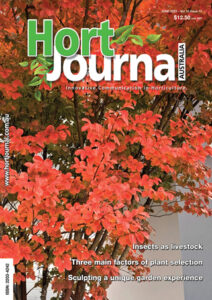Fauna, Flora and…Fungi
If organisms in the soil biome became extinct, would anyone notice? Land and sea animals, such as Tasmania’s unique Maugean Skate (Zearaja maugeana) listed as endangered, receive some publicity but some organisms could go the way of the Tasmanian Tiger without anyone noticing until it is too late.
A recent article in a magazine covered a topic that I touched on in my editorial for April about research into the relationship between plants and the soil biome. A large body of research suggests that plants have a particular need for certain types of fungi and not just any old type will do. Understanding this special symbiosis is made more difficult because there is limited mapping of the nature of the soil biome, geographically. This was further highlighted by projects attempting to reverse the severe dieback in parts of the Monaro plains at the foothills of the Snowy Mountains in NSW.
Dr Ben Gooden, a senior research scientist and ecologist with the CSIRO, maintains there is growing evidence that landscape disturbances from overgrazing, land clearing, and soil erosion seriously disrupts the connection plants make with soil fungi and other microbes. This disconnect is being seriously considered as a large contributor to the dieback and slow recovery of eucalypt species in the Snowy Mountains area.
To better understand the links between mycorrhizal fungi and eucalypts, CSIRO, in partnership with the Australian National University, Greening Australia, and Upper Snowy Landcare Network, are testing whether inoculating Eucalyptus viminalis (Ribbon Gum) seedlings with mycorrhiza improves their growth when planted into areas that have suffered severe forest dieback. This means germinating the eucalypt seedlings in soil rich in mycorrhizal fungi to begin forming the mutualistic bonds between the fungi and young plants, before planting in the environment.
The lack of data about the distribution of fungi and microbes in soils has some researchers, particularly in the Northern Hemisphere, concerned that perhaps some species have disappeared altogether and not been noticed. There is concern that possibly the microbe populations generally are in decline. Lynne Boddy, a professor of Microbial Ecology at Cardiff University in Wales, says not only are there declines in species of soil microbes and fungi but also displacements of exotic species by more common types to the detriment of plant health.
In Australia, a citizen science project called Dig Up Dirt, led by Dr Adam Frew of the Hawksbury Institute for the Environment is building a baseline map of arbuscular mycorrhizal fungal diversity. He is asking farmers or growers to send soil samples collected from their properties, according to the guidelines they provide in a kit. Arbuscular mycorrhizal fungi help plants build their defence mechanisms against diseases and insect attack, not to mention the benefits to the overall health of soil. The samples will provide information about the diversity of beneficial fungi from various agroecosystems.
The short of it is that we value what we can see and its easy to forget about what can’t be seen. We naturally get concerned about extinctions of plants and animals, and rightly so, but consideration has to be given to the ecological importance of the unseen, the fungi, which only receives 2% of global conservation priorities. Life without fungi doesn’t bear thinking about.
Enjoy the read.
Karen Smith and your Hort Journal Team

